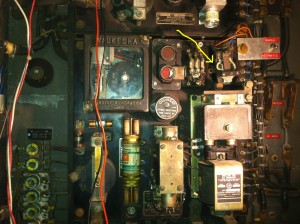After several days of prep work and now getting the ‘Enginator’ running everyone was really excited – we had really accomplished something pretty significant. But, we were sort of “out of available weekends” with our families so we decided to take a day off work (Friday) to come out to IRM.
See this photo album for pictures of the day’s work: Waukesha Enginator Day 4 – 11/04/11.
Larry Kuehn started by resplicing the high current Gen (-) cable underneath the car which was causing the unit not to crank over when the unit was rolled out on its rails for servicing. We spent hours with John Grube tracing circuits a few weeks ago attempting to understand why the unit would not crank.
At this point we were able to get it running by manually holding in the control circuit relay and manually pushing up on the starting contactor. This was great progress, but the starting circuitry was not working.
Meanwhile Chuck Trabert was working on the engine – replacing spark plug clips, filling up the radiator, checking the throttle and governor linkages, checking the operating temperature with an IR non-contact thermometer and other misc. items on the engine, using his abilities as a former mechanic, meanwhile Larry and I were in the electrical locker trying to figure out the starting circuitry. What we ended up doing was to independently test each relay on the control panel. Did the coil energize and did the contacts make/break the connection. Was there continuity from the control panel to the Start/Stop switches on the unit under the car? Did the time delay relays trip after energizing their coils for a specified amount of time?
We were joined by Buzz Morisette for lunch onboard the car. I brought some frozen Ken’s Railroad Chili and heated it up on the old Garland stove that still amazingly works.
After a couple hours of testing, we finally discovered the starting problem why the starting circuitry was working. The contacts on the Intermittent Starting Relay (shown with yellow arrow) were dirty and thus not making contact. This relay allow the engine to crank for 20 seconds before a thermal trip occurs and breaks the circuit. Cleaning the contacts did the job. The starting circuitry now worked 100%.
Now on to the next problem. A pretty big one at that. The S&C Electric “carbon pile” safety regulator for the Enginator was not working. It was stuck full on! My Sinometer new clamp meter showed it charging the batteries at whopping 168A at 44V! The lights were getting very bright and I was getting very nervous about b urning 32V stuff out. . Rather than not run it, earlier in the day we simply disconnected the generator field cable so we could run it without “frying” the batteries. It’s now late in the day and dark outside so there’s no time to work on it. It’s another job for another day. What great progress today. Everyone was pleased.
How do you troubleshoot a carbon pile regulator? You go ask our friend John Grube who had helped us immensely so far.

